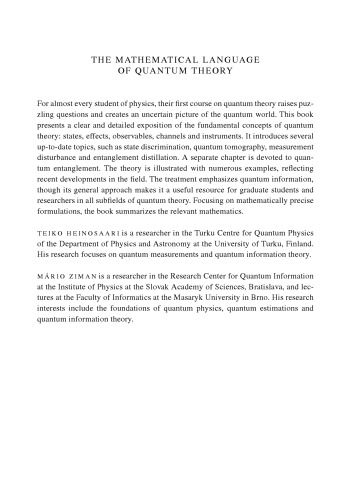

Most ebook files are in PDF format, so you can easily read them using various software such as Foxit Reader or directly on the Google Chrome browser.
Some ebook files are released by publishers in other formats such as .awz, .mobi, .epub, .fb2, etc. You may need to install specific software to read these formats on mobile/PC, such as Calibre.
Please read the tutorial at this link. https://ebooknice.com/page/post?id=faq
We offer FREE conversion to the popular formats you request; however, this may take some time. Therefore, right after payment, please email us, and we will try to provide the service as quickly as possible.
For some exceptional file formats or broken links (if any), please refrain from opening any disputes. Instead, email us first, and we will try to assist within a maximum of 6 hours.
EbookNice Team

Status:
Available5.0
6 reviews
ISBN 10: 1139031104
ISBN 13: 9781139031103
Author: Teiko Heinosaari, Mario Ziman
For almost every student of physics, the first course on quantum theory raises a lot of puzzling questions and creates a very uncertain picture of the quantum world. This book presents a clear and detailed exposition of the fundamental concepts of quantum theory: states, effects, observables, channels and instruments. It introduces several up-to-date topics, such as state discrimination, quantum tomography, measurement disturbance and entanglement distillation. A separate chapter is devoted to quantum entanglement. The theory is illustrated with numerous examples, reflecting recent developments in the field. The treatment emphasises quantum information, though its general approach makes it a useful resource for graduate students and researchers in all subfields of quantum theory. Focusing on mathematically precise formulations, the book summarises the relevant mathematics.
1: Hilbert space refresher
1.1: Hilbert spaces
1.1.1 Finite- and infinite-dimensional Hilbert spaces
1.1.2 Basis expansion
1.1.3 Example: L2(Ω)
1.2: Operators on Hilbert spaces
1.2.1 The C*-algebra of bounded operators
1.2.2 Partially ordered vector space of selfadjoint operators
1.2.3 Orthocomplemented lattice of projections
1.2.4 Group of unitary operators
1.2.5 Ideal of trace class operators
1.3: Additional useful mathematics
1.3.1 Weak operator topology
1.3.2 Dirac notation and rank-1 operators
1.3.3 Spectral and singular-value decompositions
1.3.4 Linear functionals and dual spaces
1.3.5 Tensor product
2: States and effects
2.1: Duality of states and effects
2.1.1 Basic statistical framework
2.1.2 State space
2.1.3 State space for a finite-dimensional system
2.1.4 From states to effects
2.1.5 From effects to states
2.1.6 Dispersion-free states and Gleason's theorem
2.2: Superposition structure of pure states
2.2.1 Superposition of two pure states
2.2.2 Interference
2.3: Symmetry
2.3.1 Unitary and antiunitary transformations
2.3.2 State automorphisms
2.3.3 Pure state automorphisms and Wigner's theorem
2.4: Composite systems
2.4.1 System versus subsystems
2.4.2 State purification
3: Observables
3.1: Observables as positive operator-valued measures
3.1.1 Definition and basic properties of observables
3.1.2 Observables and statistical maps
3.1.3 Discrete observables
3.1.4 Real observables
3.1.5 Mixtures of observables
3.1.6 Coexistence of effects
3.2: Sharp observables
3.2.1 Projection-valued measures
3.2.2 Sharp observables and selfadjoint operators
3.2.3 Complementary observables
3.3: Informationally complete observables
3.3.1 Informational completeness
3.3.2 Symmetric informationally complete observables
3.3.3 State estimation
3.4: Testing quantum systems
3.4.1 Complete versus incomplete information
3.4.2 Unambiguous discrimination of states
3.4.3 How distinct are two states?
3.5: Relations between observables
3.5.1 State distinction and state determination
3.5.2 Coarse-graining
3.6: Example: photon-counting observables
3.6.1 Single-mode electromagnetic field
3.6.2 Nonideal photon-counting observables
4: Operations and channels
4.1: Transforming quantum systems
4.1.1 Operations and complete positivity
4.1.2 Schrödinger versus Heisenberg picture
4.2: Physical model of quantum channels
4.2.1 Isolated versus open systems
4.2.2 Stinespring's dilation theorem
4.2.3 Operator-sum form of channels
4.3: Elementary properties of quantum channels
4.3.1 Mixtures of channels
4.3.2 Concatenating channels
4.3.3 Disturbance and noise
4.3.4 Conjugate channels
4.4: Parametrizations of quantum channels
4.4.1 Matrix representation
4.4.2 The χ-matrix representation
4.4.3 Choi–Jamiolkowski isomorphism
4.5: Special classes of channels
4.5.1 Strictly contractive channels
4.5.2 Random unitary channels
4.5.3 Phase-damping channels
4.6: Example: qubit channels
5: Measurement models and instruments
5.1: Three levels of description of measurements
5.1.1 Measurement models
5.1.2 Instruments
5.1.3 Compatibility of the three descriptions
5.2: Disturbance caused by a measurement
5.2.1 Conditional output states
5.2.2 No information without disturbance
5.2.3 Disturbance in a rank-1 measurement
5.2.4 Example: BB84 quantum key distribution
5.3: Lüders instruments
5.3.1 Von Neumann's measurement model
5.3.2 Lüders instrument for a discrete observable
5.3.3 Lüders' theorem
5.3.4 Example: mean king's problem
5.4: Repeatable measurements
5.4.1 Repeatability
5.4.2 Wigner–Araki–Yanase theorem
5.4.3 Approximate repeatability
5.5: Programmable quantum processors
5.5.1 Programming of observables and channels
5.5.2 Universal processor for channels
5.5.3 Probabilistic programming
6: Entanglement
6.1: Entangled bipartite systems
6.1.1 Entangled vectors
6.1.2 Entangled positive operators
6.1.3 Nonlocal channels
6.2: Entanglement and LOCC
6.2.1 LOCC ordering and separable states
6.2.2 Maximally entangled states
6.2.3 Majorization criterion for LOCC
6.3: Entanglement detection
6.3.1 Entanglement witnesses
6.3.2 Quantum nonlocal realism
6.3.3 Positive but not completely positive maps
6.3.4 Negative partial transpose (NPT) criterion
6.3.5 Range criterion
6.4: Additional topics in entanglement theory
6.4.1 Entanglement teleportation and distillation
6.4.2 Multipartite entanglement
6.4.3 Evolution of quantum entanglement
6.5: Example: Werner states
the mathematical language of quantum theory pdf
the mathematical language of quantum theory
the mathematics of quantum mechanics pdf
the language of mathematics book
the mathematical language of quantum theory from uncertainty to entanglement
Tags: Teiko Heinosaari, Mario Ziman, Mathematical, Quantum